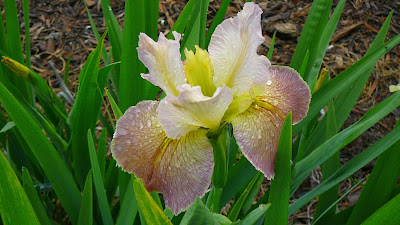By Mike Unser
Eva Faught was born in Shelbyville, Illinois, in 1888 to John and Eliza Fought (it is unknown why she spelled her last name differently from her parents). She spent her early professional years as a bacteriologist in Springfield, and relocated to Carbondale, IL, when the new offices of the State Department of Health were located there. It was here that she created a garden and started hybridizing with irises. She concentrated mainly on blue and white irises. She introduced irises thru the 1940s and 1950s. In 1955 she traveled abroad to England and then to South Africa, where she visited with her sister. A few years later she retired and moved to Cuernevaca, Mexico, where she built a small home in the style of the Midwest. She passed away in 1978 at the age of 90, having been cared for by an order of Mexican nuns in her final years.
Eva Faught was a very harsh critic of her own creations, and is said to have carried a machete with her during bloom season, ruthlessly slashing varieties to the ground that did not meet her exacting standards. Tho she was a prolific hybridizer and planted out thousands of seedlings each year, she only registered nine varieties from her garden:
'Cahokia' (1948),
'Carbondale' (1954),
'Eva Sloan' (1953),
'Illinois Sunshine' (1949),
'Lavone' (1954),
'Pierre Menard' (1948),
'Roxy' (1954),
'White Chalice' (1957), and
'White Peacock' (1944). It is unknown if the three from 1954 were ever introduced. Illinois Sunshine was a very popular yellow, but it was two of her blues, sister seedlings 'Cahokia' and 'Pierre Menard', that really brought her renown and a well-deserved place in Iris history.
'Cahokia' [above] is simply a perfect flower. It has a complex parentage involving three other classic irises:
'Santa Clara',
'Santa Barbara' and
'Purissima'. Cooley's Gardens catalog described it as: "Large exquisitely formed flowers of light butterfly-blue delicately veined deeper. There is no hint of lavender in the color and the haft is smooth and clean. Bright golden yellow beard." It really is an exceptional shade of blue, and the branching and growth habits are as good as the flowers are beautiful. The blooms are large on tall sturdy stems and often have three open at once. A high bud count keeps it blooming for a good while as well.
Pierre Menard is the name of a fictional author created in a short story by Argentine writer Jorge Luis Borges. It is also the name of one of the most important irises in the history of the development of our favorite garden flower
[above, from Cooley's Gardens catalog for 1959].
'Pierre Menard' can be found in the background of most of our modern blues because, like
'Cahokia', breeders loved its unique shade of blue and used it extensively in the creation of new varieties. Syllmar Gardens catalog for 1956 described it as: "Very large blooms of medium blue with horizontal falls. Excellent form and outstanding substance. There is a lot of blue to its coloring and the entire flower posses a lovely enamel finish. Good branching and vigorous growth. A really fine iris."
Miss Faught had a shorter career than most in the iris world, but made a very big impact. The development of modern blues would not have been the same without her contributions.
Update: it has been brought to my attention that Pierre Menard was a French fur trapper who became the state of Illinois' first lieutenant governor. Thanks to Keith Keppel for the info!
Thanks to Pam Thompson for genealogical information. Info also from AISB #110 July 1948 and AISB #227 Fall 1978.




































